Webinar text. Page 3
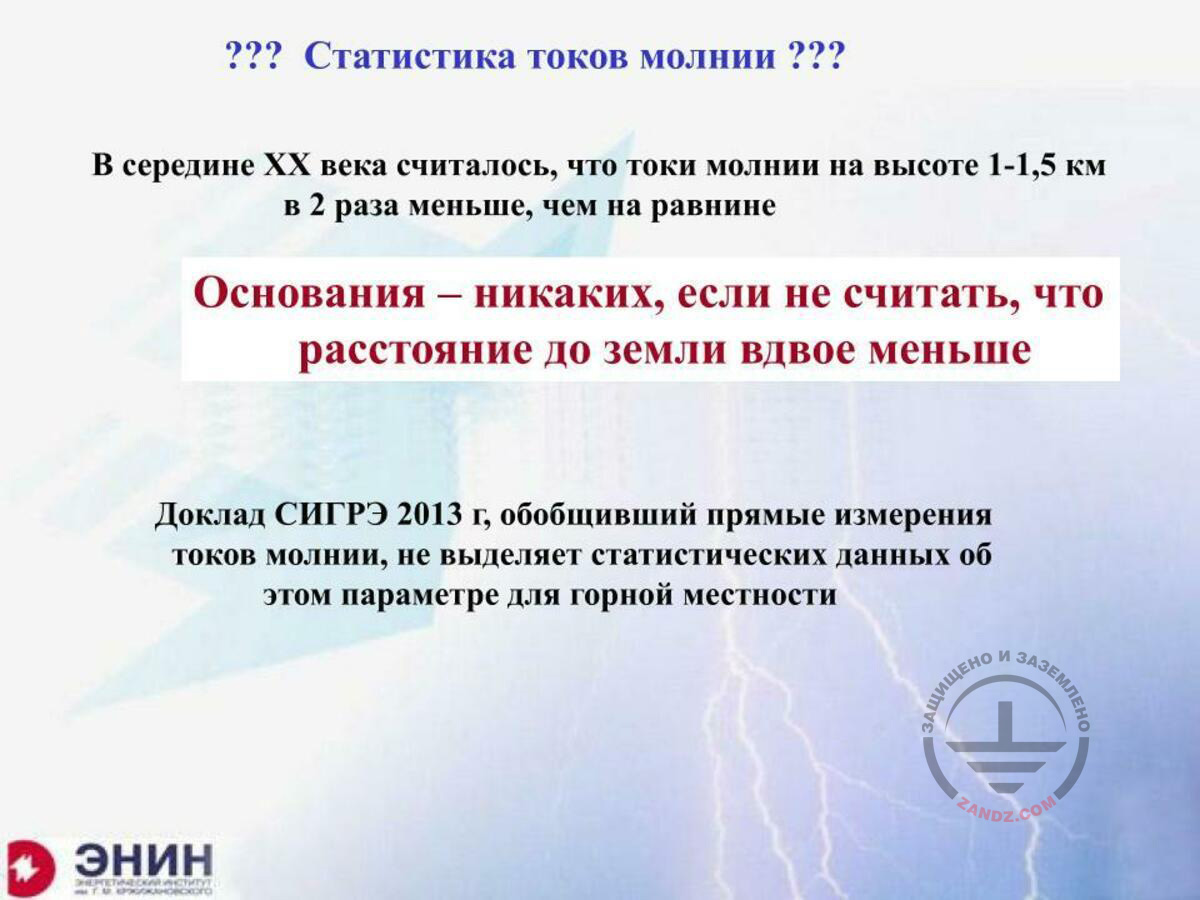
Lightning current statistics
??? Статистика токов молнии ???
В середине XX века считалось, что токи молнии на высоте 1-1,5 км в 2 раза меньше, чем на равнине
Основания - никаких, если не считать, что расстояние до земли вдвое меньше
Доклад СИГРЭ 2013 г, обобщивший прямые измерения токов молнии, не выделяет статистических данных об этом параметре для горной местности
??? Lightning current statistics ???
In the middle of the 20th century, it was believed that lightning currents at the altitude of 1–1.5 km are twice less than on the plain
There are no reasons for this except for the fact that the distance to the ground is twice less
The 2013 CIGRE Report that summarized the direct lightning current measurements does not isolate any statistical data on this parameter for mountainous areas
We have a serious question then: what is the current statistics like in mountainous areas? Unlike the lightning strike itself, the strike of the lightning carrying a dangerous current is important for us. And we need to know the lightning current statistics for the facilities located at the altitude of 1.5 km, 1 km, or 2 km. What do we have here? Read the latest CIGRE Report containing all actual data on lightning currents. I have looked through this report from the beginning to the end once again before this seminar. No changes in the lightning current statistics were noted there. The lightning current statistics has been provided irrespective of the areas on the ground, i.e. it does not matter whether it is a gorge, a tropic area, or any northern regions. Can this statistics change? This is a very serious question. If you read a book published about 50 years ago, you will see that, in mountainous regions, the lightning currents are said to reduce about 2-fold compared to those on the plain. And it is mentioned that, with the same probability, you should calculate the lightning current in mountains two times less than on the plain. And I began thinking of where did this come from? Who invented this and what was the reason for it? You know, I could only think of one thing: a storm front is approaching at some altitude, but when it is above the mountains, the distance from the storm front to the ground surface is reduced twice. And due to the fact that it becomes twice less, the breakthrough voltage of the gaps occurs twice less.
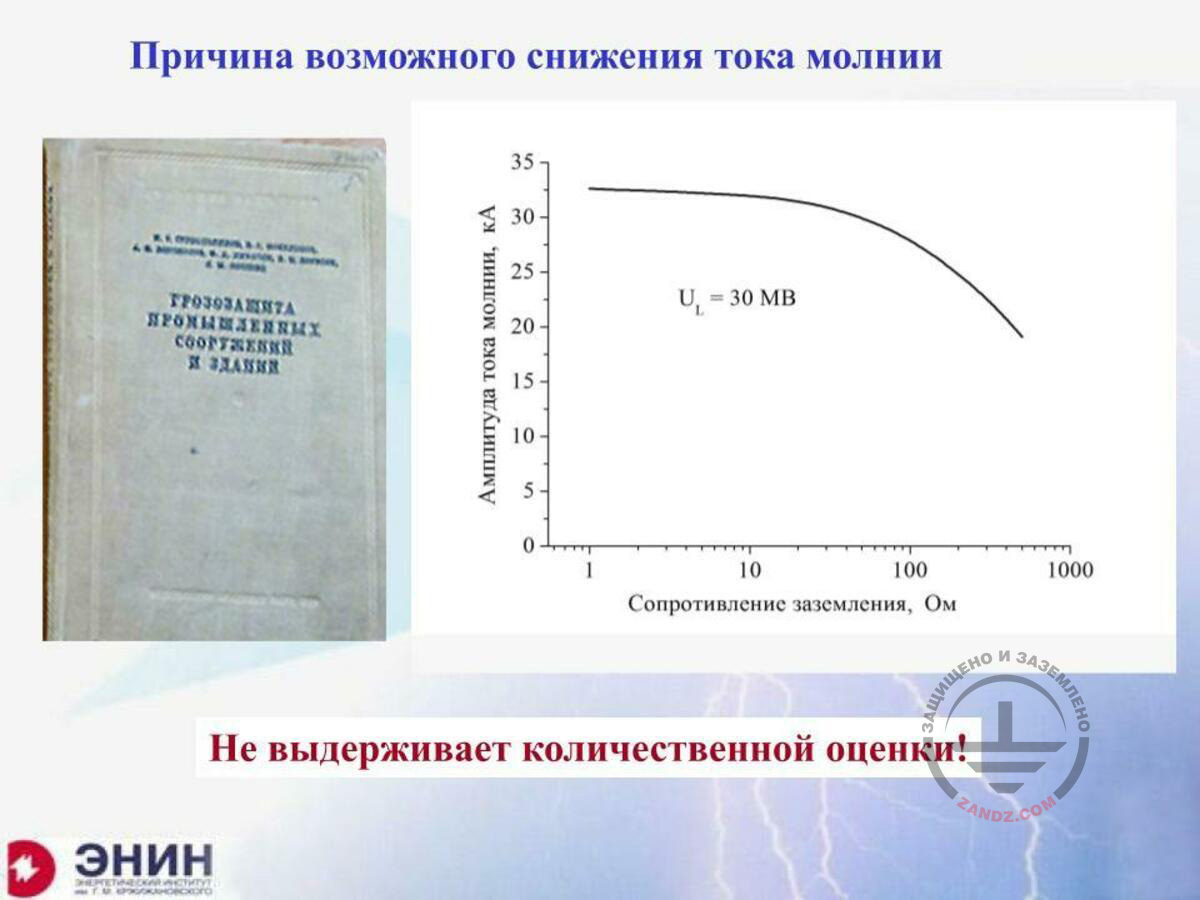
Reason for possible reduction in the lightning current
Причина возможного снижения тока молнии
Не выдерживает количественной оценки!
Амплитуда тока молнии, кА
30 МВ
Сопротивление заземления, Ом
Reason for possible reduction in the lightning current
Does not hold up against the quantitative estimate!
Lightning current amplitude, kA
30 MV
Earthing resistance, Ohm
A book titled "Storm Protection of Industrial Structures and Buildings" was published in 1951 in the Soviet Union. The book is actually the first regulatory document for lightning protection. In particular, it is one of the first documents. And this book states that, in mountainous areas, the current is twice less than on the plain. I began reading it string by string and found another reason for that. It appears that bad soils, rocky soils, are present in mountains. And it means that the earthing resistance of the facility is high; if it is high, the current must be reduced. And they reduced it 2-fold. When I found this, I began doing the following thing right away: I started calculating how the earthing resistance affects the lightning current. The dependence is shown in the diagram. In the lower part, the earthing resistance is shown in the logarithmic scale. To reduce the lightning current 2-fold, the earthing resistance should reach about 1,000 Ohm. But there are no facilities with the earthing resistance of 1,000 Ohm. The authorities will not allow their operation because the standards for earthing resistance in mountains do not differ much from those for the plain. They do not differ at all. They depend on soil resistivity, and you are not allowed to have more than 30 Ohm, e.g., for power utilities. It means that it is an impossible situation. What situation can it be? And one more point. What can be at all?
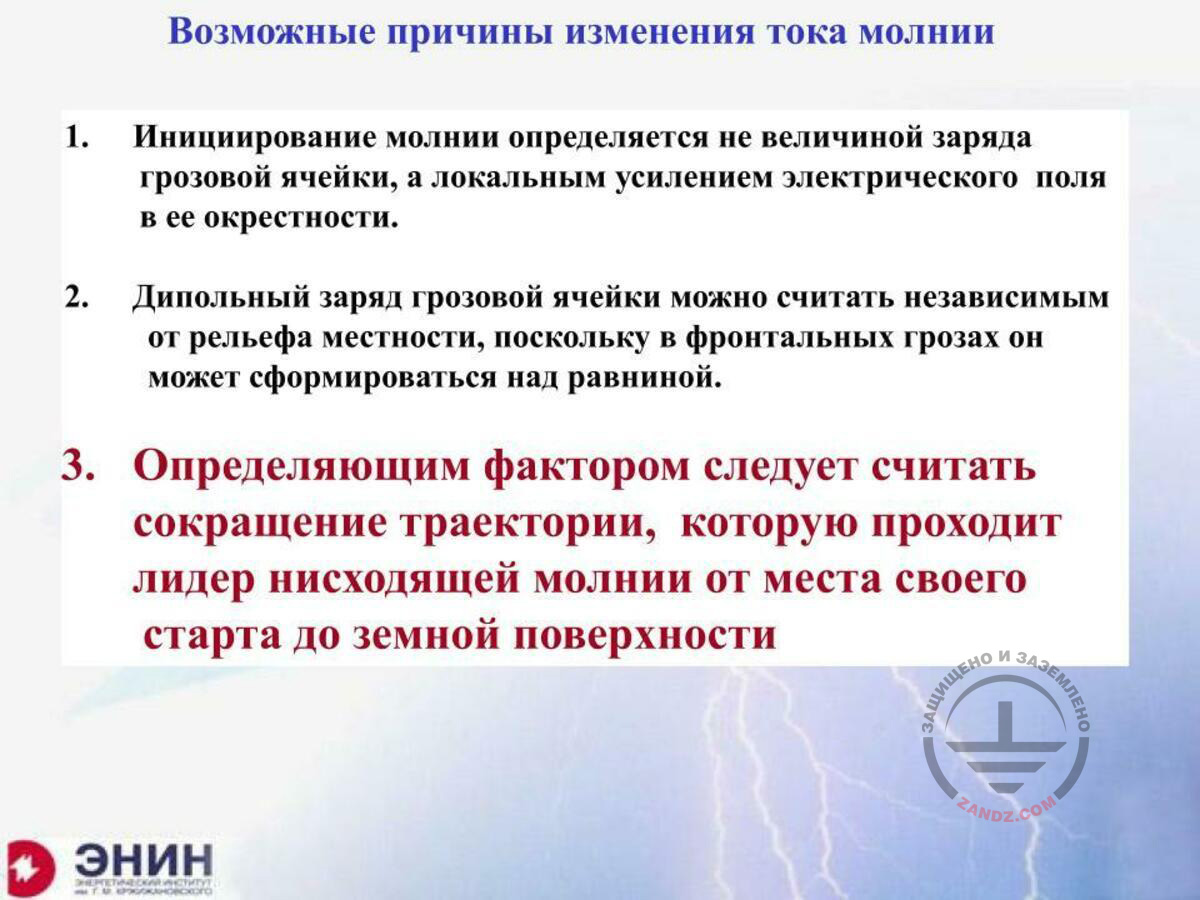
Possible reasons for the lightning current change
Возможные причины изменения тока молнии
1. Инициирование молнии определяется не величиной заряда грозовой ячейки, а локальным усилением электрического поля в ее окрестности.
2. Дипольный заряд грозовой ячейки можно считать независимым от рельефа местности, поскольку в фронтальных грозах он может сформироваться над равниной.
3. Определяющим фактором следует считать сокращение траектории, которую проходит лидер нисходящей молнии от места своего старта до земной поверхности
Possible reasons for the lightning current change
1. Initiation of the lightning is determined not by the charge of a thunderstorm cell, but by a local strengthening of the electrical field in and about it.
2. The dipole charge of the thunderstorm may be considered to be independent from the terrain because it may form over the plain in case of frontal storms.
3. The main factor may be the reduction of the path of the downward lightning leader from the location of its start to the ground surface.
Let's look at what it can be. Why does the lightning current may change? I am not saying “reduce” but I am only using the word “change” now. The first point is a charge of a thunderstorm cell. Can it reduce over the mountainous area? No, it cannot. The reason is that usually, the thunderstorms are frontal, and the charge of these thunderstorm cells is gained somewhere on the plain; and then, this front goes over the mountain, and it is clear that the charge will not change. The second point is the distance between the lower and the upper charges of the thunderstorm electric dipole. Again, it is formed somewhere far away, and goes over the mountain, and it will not change. What can essentially change?
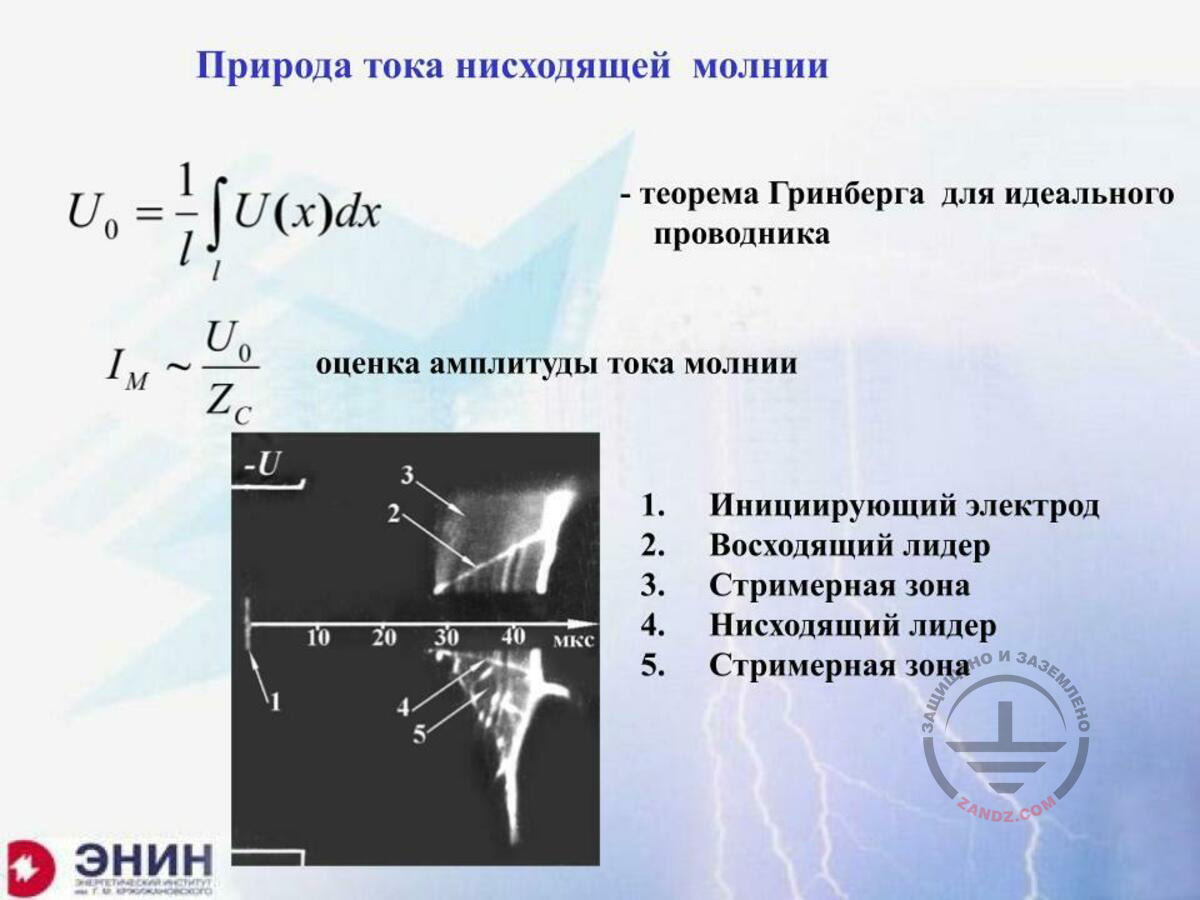
Nature of downward lightning current
Природа тока нисходящей молнии
- теорема Гринберга для идеального проводника
Оценка амплитуды тока молнии
1. Инициирующий электрод
2. Восходящий лидер
3. Стримерная зона
4. Нисходящий лидер
5. Стримерная зона
Nature of downward lightning current
- the Grinberg’s theorem for an ideal conductor
Evaluation of the lightning current
1. Initiating electrode
2. Upward leader
3. Streamer zone
4. Downward leader
5. Streamer zone
This issue is defined as follows: somewhere in the thunderstorm or maybe very close to the boundary of the thundercloud, ionization conditions are generated. When we studied thunderstorms, there were no strong electrical field inside of them. When thunderclouds were probed, the maximum strengths of the electrical field were about 4 to 5 kV per 1 centimeter. And for the normal density air to ionize we need 30 kV instead of 4–5. It means that the location where the field increases is somehow formed locally. How can the electrical field be strengthened? We can use mechanical vortexes to drive the charge out. We can make a conductive plasma body in the location, e.g., using a space radiation. Today, neither of these hypotheses was confirmed; however, it is clear that such area with the strengthened field must exist. And if the discharge appears in it, then such discharge will go from this area in two directions. This is the way it is shown in the laboratory. A conductive body is located here. A discharge goes upward from its upper end, while from its lower end, the discharge of a different polarity goes down. And such a bipolar system is the system that forms the lightning channel. We are usually interested in the lower end. Thus, the potential that the channel brings to the ground is defined by the Grinberg's theorem and is equal to the voltage along the length of the channel from the cloud to the ground. It can be calculated for the lightnings starting in different points and moving along different paths.
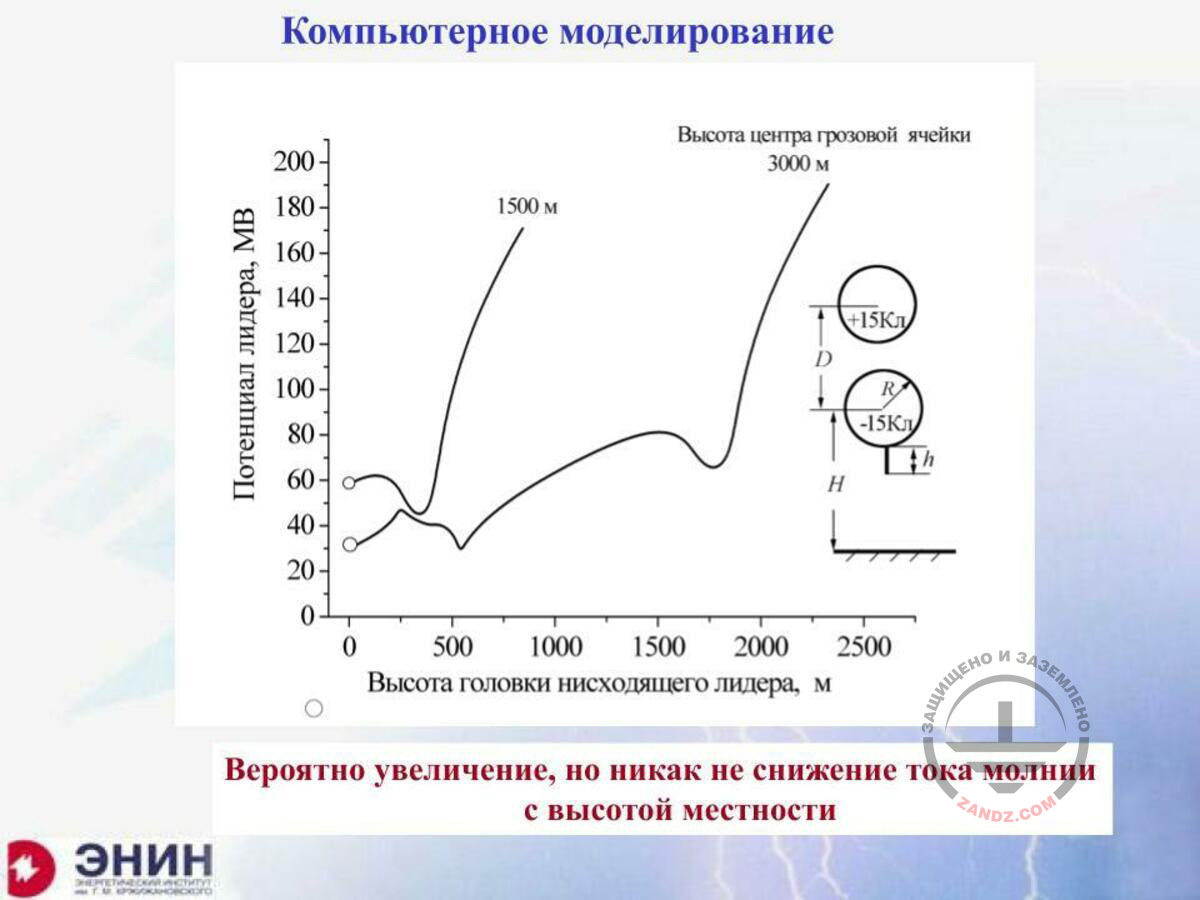
Computer modelling. The lightning current increase
Компьютерное моделирование
Потенциал лидера, МВ
1500 м
Высота центра грозовой ячейки
3000 м
+15 Кл
-15 Кл
Высота головки нисходящего лидера, м
Вероятно увеличение, но никак не снижение тока молнии с высотой местности
Computer modelling
Leader potential, MV
1,500 m
Height of a thunderstorm center
3,000 m
+15 C
–15 C
Height of the downward leader head, m
The increase rather than the reduction of the lightning current along with the terrain altitude is probable
I have performed such calculation before this seminar. Here is a bipolar system. This is the upper, positive charge of a thunderstorm cell and the lower, negative charge of a thunderstorm cell. The lightning starts from the igniter and goes to the ground and upward, but I am not interested in the upper lightning. And I perform such calculation for two cases: when the distance is three kilometers, which is somewhere about the length of the lightning on the plain, and when the distance to the ground is 1.5 kilometers as it is reduced due to the mountainous area. So, what do we have here? The potential brought by the lightning of 3 kilometers long is about 30 million V, while the potential brought by the short lightning after passing the path of 1.5 km is 60 million V. And now, I have two systems.
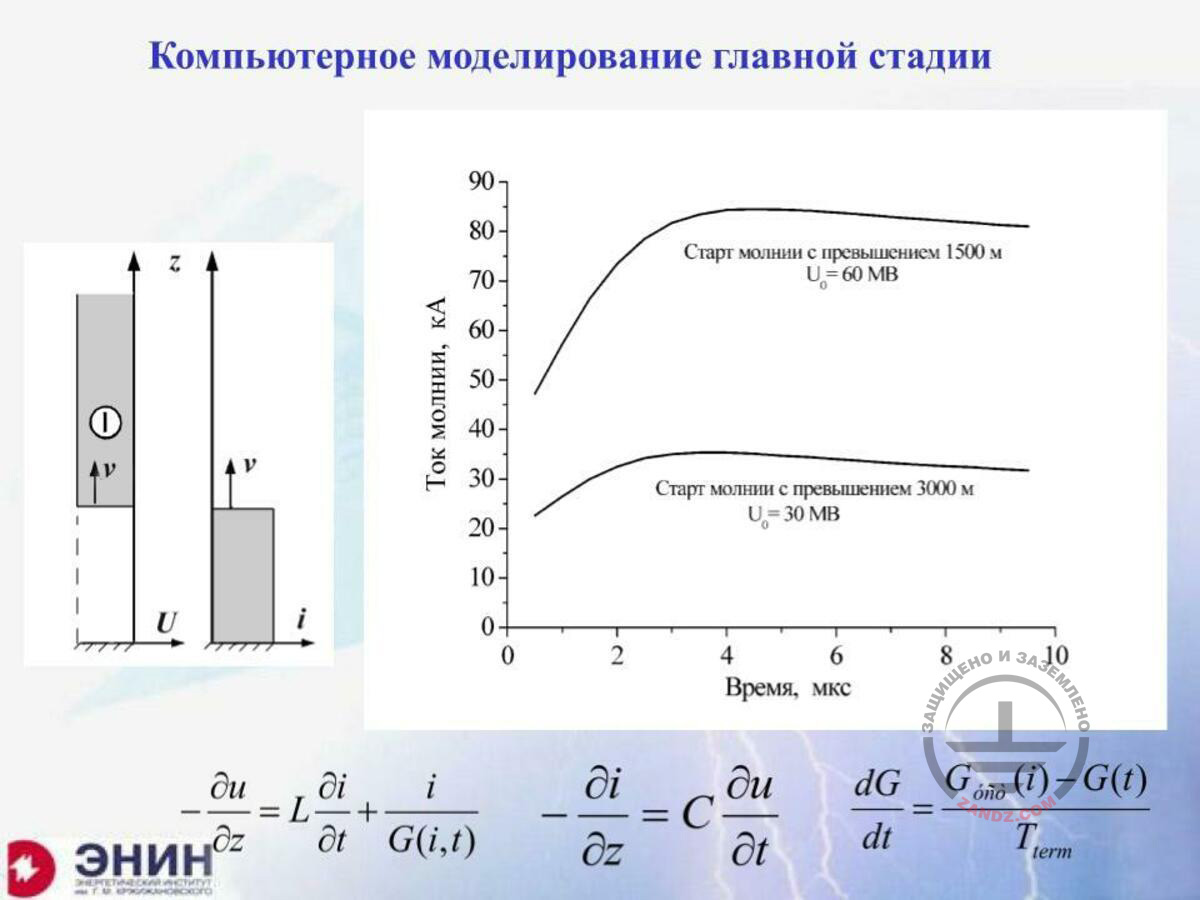
Computer modelling of the main stage
Компьютерное моделирование главной стадии
Ток молнии, кА
Старт молнии с превышением 1500 м
60 МВ
Старт молнии с превышением 3000 м
Время, мкс
Computer modelling of the main stage
Lightning current, kA
Start of the lightning with the elevation of 1,500 m
60 MV
Start of the lightning with the elevation of 3,000 m
Time, mcs
And now, I am investigating what happens when the ionization wave occurs, which takes the charge off this channel, and the current wave is formed. The current that goes in the long channel is about 35 kA, while the current in the short channel will be about 85 kA, i.e. the following situation happens. Although in the mountainous areas, the current statistics does not change, it must change in a completely different way. The current amplitude should reduce rather than increase. Neither such increase in the lightning current nor the reduction of currents in the mountainous areas have been recorded in practice. So, what should we do? There is only one situation: for now, we have to use the available current statistics, i.e. the one provided by CIGRE. You cannot ignore it, but if you believe in what I have just shown to you, then you can use the increased estimate current in your calculations. You can calculate the entire system, for example, not for 100 kA that have to be used for the third level of lightning protection according to SO 153, but rather use the current increased about two times, and then calculate all the rest parameters. Store is no sore. This does not contradict any document because you have the right to increase reliability. And then, for such mountainous areas, it will be more rational to consider that the lightning currents there will be more but not less than the currents on the plain. This is the situation. And we have to take it because we cannot do anything else yet. So, I will summarize again: in the gorge, you may avoid installing lightning arresters because the gorge walls of even a wide gorge, which is, for example, 100 or 200 meters wide, provide a very good protection, if they are 20–40 meters higher than the facilities. It was the first point. The second point is that the facilities installed on the elevated hills, rocks, and other locations, certainly suffer from more lightning strikes. But we can only calculate such increased number of lightning strikes individually by taking into account all facility dimensions and the entire profile of the hill, rock, or other location, where the facility is installed. You can calculate it, but there is another issue: how can we calculate the protective action of lightning arresters in this case? There are no rational ideas concerning this yet. The third point: the outdated ideas of that the lightning current in the mountainous areas is twice less than that on the plain are a clear mistake. Even if the lightning current changes in mountainous areas, it should inevitably be more than the currents on the plain. And this point can be considered, if you do not take into account anything else, by introducing, into the calculation, the current that is about twice more than the one used on the plain. That is how I would have concluded this SciFi lecture or webinar, because I cannot provide you with any proofs like “Look, it has been measured!” Nothing has. Now, I am ready to answer your questions.
Questions and answers
– Eduard Meerovich, thank you very much for your report. We have some questions, so let's read them one by one. “How can you comment on the item of EIC 2.5.129 stating that, for the mountainous supports of the power lines located at the altitude of over 700 meters over the sea level, the earthing resistances may be increased 2-fold?” If you can, do it, please.
– You know, the thing is that there are two points allowing their increase. First, in general, the EIC requirement for the resistance of the supports of the power lines depends on soil resistivity. And if your soil resistivity is, for example, 100 Ohm*m, then the support's earthing resistance may not be more than 10 Ohm, while with the soil resistivity of 1,000–3,000 Ohm*m, it is allowed to have 30 Ohm instead of 10 Ohm. The EIC allows increasing the earthing resistance for the supports depending on soil resistivity. But frankly, I do not understand this point. There is one more thing I cannot understand: how to make the earthing resistance of the support in the soil having the resistivity of 3,000 Ohm*m equal to 30 Ohm. We have made calculations for what we should do. To obtain such earthing resistance, we have to install the horizontal bus with the length that is approximately equal to the length of the distance between the supports. In this case, we will achieve such earthing resistance And if you do not want to use the horizontal bus but you still want to provide a focused earthing device, then you need to use the soil area near the support of about 100 x 100 meters, which is never feasible. Although, I think that the extract you have read is associated with the outdated idea of that the lightning current in mountainous areas reduces along with the increase of the height of a mountain over the sea level. But according to the current ideas, it cannot be like this, but the EIC contains many of such equivocal points. There are several surprising point existing in the EIC. That is what I meant.
– You know, this question is not for me. It is a question for the owners of this company. Each company determines the regulatory documents to be used. Today, virtually all industries develop their own standards. And they specify, which regulatory documents and requirements you should stick to. Standards RD 34 and SO 153 have been developed irrespective of any industry. In general, they can be used in any industry, unless otherwise specified. But they are specified by the management in the industry, but not by the specialist in lightning protection.
– Good, thank you! Before asking the next question, Gasym, please clarify your question about the mountainous villages located at the altitude of 3–3.5 km, and I will read it. Next question: “Are there any references to the Mezgin's works you have mentioned? Were the results of his studies used in any regulatory documents?”
– Yes, if you have a look at the proceedings of our recent conferences for lightning protection, e.g., in 2012–2018, then you can see that he is a permanent participant of these conferences. And you can find the references at least there. This is the first point. Second, approximately in the mid-80s, the unified energy system of the USSR adopted a decision on the possibility of installing the power lines of voltage class 110 kV, 220 kV, 330 kV, without using the wire lightning protection if they are installed in the gorges. There was a special instruction for this. And it is carelessly followed; the operation of these power lines without any wires in the gorges has demonstrated that the reliability of power supply without wires has improved. Why? It is because the gorge walls protect these lines in any case, but the absent wires do not break and do not cause any short circuits.
– Clarification: “If the protected facility is located closer to the gorge wall, then should we protect this facility against lightnings?”
– I have already said that if your gorge is even 200 meters wide and if the edge of the gorge is higher than the facility for, e.g., 30 meters, then you do not need to install the lightning protection even though the facility is located in the middle of the gorge. But when you approach the wall, then naturally, the protection reliability increases.
– I will read the question, Eduard Meerovich, and if it is not clear, we will ask for clarifications: “What can we do to protect service buildings? It is a shelf located on the slope”.
– What can I say? Let's start with another question about villages. It has not been clarified yet although I have seen such settlements. I have been to Pamir. We had a laboratory there at the altitude of 2,400 meters. And when we were heading to this laboratory, we saw such objects. Certainly, there is no lightning protection in such buildings because they are single-level. It is a building of 3–4 meters high. The lightning protection is never considered and never done there. And the protection reliability of the facilities located on the mountain slopes is increased due to their location in this area, but in order to calculate such reliability, we have to perform certain computer calculations I have mentioned before. Surely, their protection reliability will be much higher than on the plain. But naturally, I cannot say to what extent without any calculations, and nobody can. We have to calculate it. You know, such problems occurred when the power system was built in Sochi for the 2014 Winter Olympics. Then, there was a situation when we had many facilities and many supports, which were located anywhere, including on the tops of the elevated structures. What did we do there? To provide the reliable power supply for the enterprises and structures associated with the Olympic Games, the surge arresters were installed on the supports of the power lines and thus all problems were eliminated.
– Thank you! “Do the lightning current buildup and drop parameters change for mountainous areas 10/350?”
– You know, I would like to see the person who obtained at least one oscillogram of the lightning current in mountainous areas. I repeat what I said in 2013. CIGRE is an international organization dealing with large electric grids, and it has collected all reliable data for the lightning currents. By the word “reliable”, they mean the data representing the oscillographic record of the lightning current. They obtained several hundreds of such oscillographic records worldwide. They could not tie these records to any high mountainous areas because they had no data. That is why we cannot answer this question today until such measurements are made. We can do nothing.
– Thank you. One more question: “How can we create an earthing device in the mountainous area with high soil resistivities?” And if I understand it correctly, there is also a clarification: “Is it feasible to use the so-called electrolytic earthing for high-Ohmic soils in mountainous areas?”
– Let's start from the end. The advertising materials of different companies selling reactive earthing devices (i.e., the electrolytic earthing devices) contain different information. They say that the lightning current is reduced 10 times or even 20 times. But I do not know how it is achieved. And neither company discloses the measurement technique: “We have done this, look here”. I only have the measurements made by my colleagues in Russia with our participation. They were made by the Amnis company that provides lightning protection. A simple thing was done there: such electrolytic earthing devices and identical earthing devices without anything inside of them except for enclosure were buried in the flat area having the soil resistivity that is a little bit lower than 400 Ohm*m (which means mediocre soils). All of them were monitored for 1.5 years in winter, in summer, in rain, in dryness. And we ascertained that the electrolytic earthing devices reduced their earthing resistances compared to the conventional earthing devices about 3 times, a little bit less than 3 times. This is a pure fact. If somebody showed me the same results in rocky soils, I would have understood how to deal with it. But nobody shows such results in the scientific literature. And I do not trust any advertising materials. But there is one more aspect I have become alert about. It is as follows: imagine that instead of the 3-fold decrease in the earthing resistance I have mentioned before, the earthing resistance in the bad soil will reduce about 10-fold. What does it mean? It means that, in any case, this earthing device will have the earthing resistance that is higher than required according to our standards associated with the power equipment operation. Thus, such earthing devices should consist of more than one rod, e.g., they must include five or even ten rods, etc. But the efficiency of these earthing devices will certainly decrease along with the increase in their number. Where are the results? Who can show today how the reactive earthing devices work in large companies? There are no such results. And no company wishes to demonstrate them. Let's persuade our, your, or any other managers to provide such measurements, since they are not that expensive. They are not expensive but it is unlikely that the people selling such earthing devices will spend money on something like that, because it can be their subvertisement.
– Thank you. We have a particular question: “The facility is more than 30 km long, and its height is 1,200 m; it is a ropeway. What recommendations can you provide to protect it?”
– You know, I think that it should be a very serious project because the ropeway probably does not go to the gorge. And most likely it will not be located in the gorge and it will be open. So, if you need to protect this ropeway, then you can do that, although I know how they are operated in Europe. In the storm, the operation of ropeways in mountains is prohibited. And myself and the member of my family were in the situation when we had to wait for the end of the storm because such ropeway was stopped. It happened in the Alpine highlands.
– Thank you. “Regarding the lightning current, it can be associated with the air rarity and, as a result, with the amount of free ions. And if we are talking about soils, then it appears that, in the equal start conditions of the lightning, the currents in the bog and in the rocks will be significantly different. Question: is it due to the difference in earthing resistances?”
– First, let's begin with the simple thing. Let's begin with the fact that the air density that varies by about 20% at the altitudes we are talking about does not almost affect the current characteristics and it cannot do that. We have studied the spark discharges in mountainous areas for a long time. And we know very well the specifics of the long spark discharge in the reduced air density. We are completely sure that no specific impact takes place here. And I have begun with that I showed that the air density impact within the limits important for the practical implementation is of no particular importance. Now, about the strikes into the bog and into the rock. In order for the earthing resistance to reduce the lightning current about twice, we have to move from the resistance of 10 Ohm (a bog) to the resistance of 1,000 Ohm, which is the earthing resistance in a mountainous area. If it is like this, then the lightning current will certainly reduce. But tell me please, what kind of facility has the resistance of 1,000 Ohm? How can it work in practice? How can we supply power to it? All standards state that the facility with such earthing resistance must not be operated, that is why I have not talked about it.
– Thank you. One more clarification: “Can we consider the hill slope near the facility as a wire lightning arrester?”
– It depends on the slope. We have to calculate, again. There is nothing more you can do except for calculations. The calculation can be made and it is not difficult. Is it clear? It is not difficult at all. I can mention, for example, that there is a software available for calculating lightning arresters, which is used by our today’s hosts. This software is available for everyone. Please do the following thing: assume that this mountain slope is a wire system that is located, for example, in the following way: the first wire is at the height of 10 meters and is horizontal, the next wire is at 20 meters, then at 30 meters, etc. Install them on a slope and calculate the protective action. You will obtain a reliable, high-quality value. Such modelling is feasible and successful. It is easy to do and we have the software available for it. Then, you will obtain the result for your slope.
– Dear colleagues, I am sending the link http://calculations.zandz.com/ to the calculation service mentioned by Eduard Meerovich. The only point is that we are now moving to another website, I hope that you have already noticed it, and the changes are also being made to the calculation service. So, not all functions may be available at the moment. Therefore, after some time, perhaps, in a couple of days, you will be able to log in and use it. The service is free of charge, you may register and use it. Write to us, if you have any questions. We will help you by providing answers. Question from Saveliy: “There is a waterfall about 50 meters high. What measures are recommended to protect the structures located directly near the waterfall?” Can you comment on this?
– Think of this waterfall as a gorge wall, that is it.
– Thank you. Question from Alexander: “We are engaged in the development of non-standard products, structures: temporary structures, non-capital objects, mobile complexes. Our main standards for the lightning protection relate to the buildings, structures, and industrial utilities and do not cover the mobile complexes. It means that there are no direct regulations for our products. According to which regulations should we provide the lightning protection in our case? What can we do?” Can you recommend anything?
– You know, yes, I can, because RD 34 contains sections related to the lightning protection of the facilities being under construction. A facility under construction is almost the same as a temporary facility. If you follow recommendations from this section, it will be fine. And here, we have had a special webinar dedicated to the construction sites. And I think that probably Anatoly can confirm that the record of this webinar is available and you may watch it. Am I correct?
– You are. If you give me a minute, I will find it and send the link in the chat. Good, thank you! Question from Sergey. It is general and it is a little beyond our subject: “Do the ready-made devices currently exist, which are able to record lightning strikes and register lightning parameters, as well as to systematize and generalize data? Does anyone produce them?”
– I will answer your question with pleasure. The point is that several years ago, in Russia, a device for automated recording of the lightning current was developed and tested in industrial conditions on the operating power lines. This device is an electronic unit with a standalone power supply that does not require any operating activities throughout the entire storm season. It can be installed on the support of the power line in spring and then de-installed in autumn, and you can read the information recorded therein using a regular USB drive. This device was developed by two organizations. The first is the Shatura branch of the United Institute of High Temperatures of the Russian Academy of Sciences. The second is my Krzhizhanovsky ENIN. We offer this device for massive use and we note that, in case of massive use, the cost of a single set of such equipment will be not more than one hundred dollars. If we install about a thousand pieces of such equipment in the facilities of medium heights throughout Russia, we will be able to obtain the lightning strike statistics that will be unprecedented. In any case, it will be competitive related to the data collected by CIGRE in different countries. You only need money for that.
– Thank you. Dear colleagues, I have already sent the link to the webinar record mentioned by Eduard Meerovich earlier. Eduard Meerovich, how much time do we have? According to our agenda, we have 5 more minutes.
– OK, if you have any questions, we can read them. There were many various comments; therefore, the questions have disappeared from the chat. “So, if we install the copper conductor about 2 km long in a mountainous area with the soil resistivity of 2,000 Ohm, we do not need the electrolytic earthing?”
– Look. We protect against lightnings, don't we? How much time is required for the front of the lightning current to build up? If this is the first component, then the average duration of the lightning current front is about 5 mcs; however, if we are talking about the shorter pulse of the first component, then it is about 1 mcs. If we are talking about the subsequent components, then the shortest fronts are about 0.2 mcs. Why am I talking about this? It is because when you install a long earthing device, e.g., that has a kilometer length, in a bad soil, then, in such soil, this earthing device will not begin working immediately but it will start working only when the current wave begins flowing along the device. This current wave should flow along the earthing device within the time that is much less than the current front duration. Otherwise, the current has already increased, but the resistance has not yet established. So, if it is the earthing device that is not even several kilometers but rather several hundred meters long, then it will begin working within the time of about several microseconds or even several dozens microseconds. Therefore, it makes no sense to install such lengthy earthing devices, so they are not installed. In addition, high price is also important.
– Is it a question or a statement?
– It is a statement, of course. What should you do? You should generally provide a trench of one kilometer long to place it underground. Moreover, it is desirable to prevent people or animals from being there, otherwise they will be exposed to the touch and step voltage.
– Thank you. One more clarification for the slides: “How can you explain the fact that sometimes the Earth's electrical field is shown to be positive, whereas sometimes it is negative? I had a situation when someone asked about it and I could not find a precise answer. They began persuading me that, on the earth surface, the charge is always negative and that it is also stated in Wikipedia. I am sorry for the amateur's question”.
– No. Let's look into the standard situation, and, in particular, into the standard situation typical of Russia. If we are talking about Russia, then usually the lower thunderstorm cell is charged negatively. And it means that, on the earth surface, we will have a positive charge. And it means that the electric-field vector on the earth surface will go bottom-upwards. It means that the negative charge will go to the ground but not in the opposite side. Situations exist when polarities of the thunderstorm cells vary, e.g., it is often recorded in the Far East in the Japanese registration sites. Their winter storms have positive charges of the lower thunderstorm cells, and the electric-field vector there, the ground charge becomes negative and the electric-field vector is directed in the opposite side. Both situations happen, but for Russia, for our regions, usually, the lower thunderstorm cell is negatively charged, while the ground charge is positive.
– Thank you. Dear colleagues, we had questions regarding the webinar record. I have sent the links. The records will be published on our website, in our YouTube channel. It is usually made within several days after the webinar. One more question, which will be the last one because we have run out of time. Unfortunately, our time for the broadcasting is limited. “Eduard Meerovich, please clarify. We had several questions about the earthing in mountainous areas. Please provide several recommendations on what we should do with the earthing in mountainous areas?”
– Let me tell you something. The vast majority of the lightning current recordings has been made in Switzerland. They were made by a team of a very famous researcher, Berger, which is located on Monte San Salvatore on the shore of Lake Lugano. There, on this mountain, which is 600 meters high, a tower was installed with the height of 70 meters. And all the equipment recording the lightning currents is located on it. The team obtained numerous recordings. This 70-meter high mast is earthed as follows: a metal bus is going down from the mountain into Lake Lugano, and the earthing device is located in the waters of Lake Lugano. They could do nothing else. Let me provide you with another example: Russia sells electrical energy to other countries, including Finland. We have power lines that go from the northwestern Russia through mountainous areas in Karelia to Finland, and rather often storm blackouts were observed in those places. They began inspecting the lines and found the supports that had the earthing resistance, which was 10 times more than the intended 30 Ohm according to the field, as I have already mentioned. What did they do there? It was the following thing: they made trenches of 30 meters long, 1.5 meter deep and of the same width, where they put the clay taken from 20 km away, and then installed the horizontal earthing buses. And it helped. I can provide you with one more example. It is related to the northwestern district of Vyborg. There is a guarding point that passes cars from Russia to Finland and vice versa. To provide high-quality earthing in the district, they used the transported soil at the depth of about 3 meters, and they installed all earthing devices into that soil. Is it clear? It means that you cannot do it cheap. I did not want to recommend such electrolytic earthing devices for you because I cannot imagine how they will operate in a rocky soil. What is the electrolytic earthing device operation based upon? They take moisture out of the soil through the drain holes in their chemical cartridges; they essentially dissolve these chemical cartridges partially, and the electrolyte exits and goes again to the soil, thus reducing its earthing resistance. Now imagine that I have put such electrolytic earthing device into granite. I exaggerate the situation intentionally. Tell me please, does granite contain much moisture? What will it take?
– Thank you! Dear colleagues, I think that Eduard Meerovich has provided several examples that allow for some conclusions. Regarding questions, they keep coming, but unfortunately, the broadcasting is finished. First, we will save all questions from this chat and check, which of them have not been answered yet. We will take them and send to Eduard Meerovich.
– I will surely answer them.
– After that, we will publish them with answers on the website and send them by e-mail. Write it in the chat or by e-mail, whether it is convenient. I will send the e-mail in the chat.
– You know, these webinars and communication with you are very important for me. With your questions and your activity you encourage people for new work, so thank you very much! Thank you for your participation and your questions! I wish you a success!
– Thank you, Eduard Meerovich, for your great presentation! Words of appreciation as well as wishes for you to live long and have a good health and continue with your work keep coming in the chat.
– Thank you! It is good for everyone! All the best!
– Dear colleagues, thank you! The webinar is finished. See you soon in the next webinars!
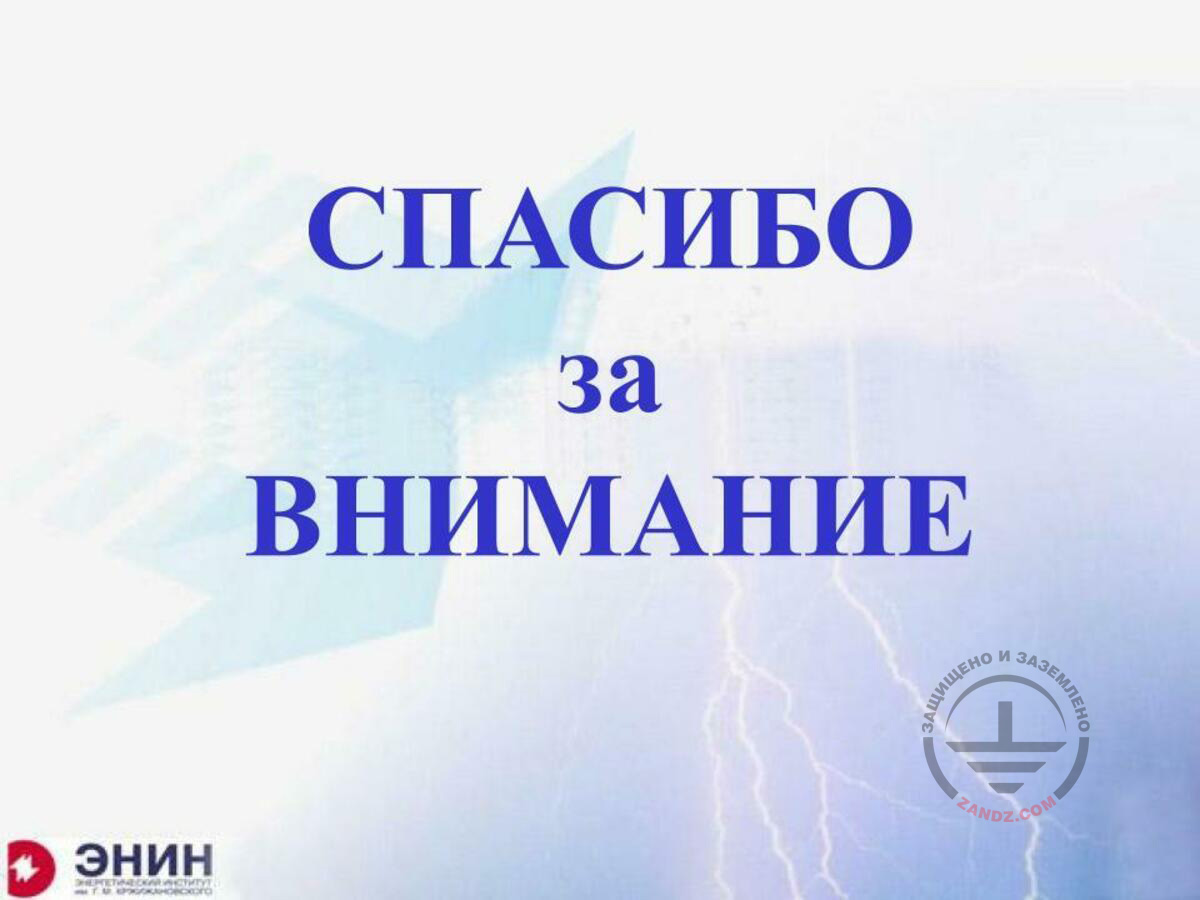
Thank you for attention
СПАСИБО за ВНИМАНИЕ
THANK YOU FOR YOUR ATTENTION!
<< Previous page
slides from 8 to 14
Related Articles:
 Lightning Protection of Large Territories: Parks, Grounds, Plant Territories. Page 1
Lightning Protection of Large Territories: Parks, Grounds, Plant Territories. Page 1
 Lightning Protection of Large Territories: Parks, Grounds, Plant Territories. Page 2
Lightning Protection of Large Territories: Parks, Grounds, Plant Territories. Page 2
 Lightning Protection of Large Territories: Parks, Grounds, Plant Territories. Page 3
Lightning Protection of Large Territories: Parks, Grounds, Plant Territories. Page 3

